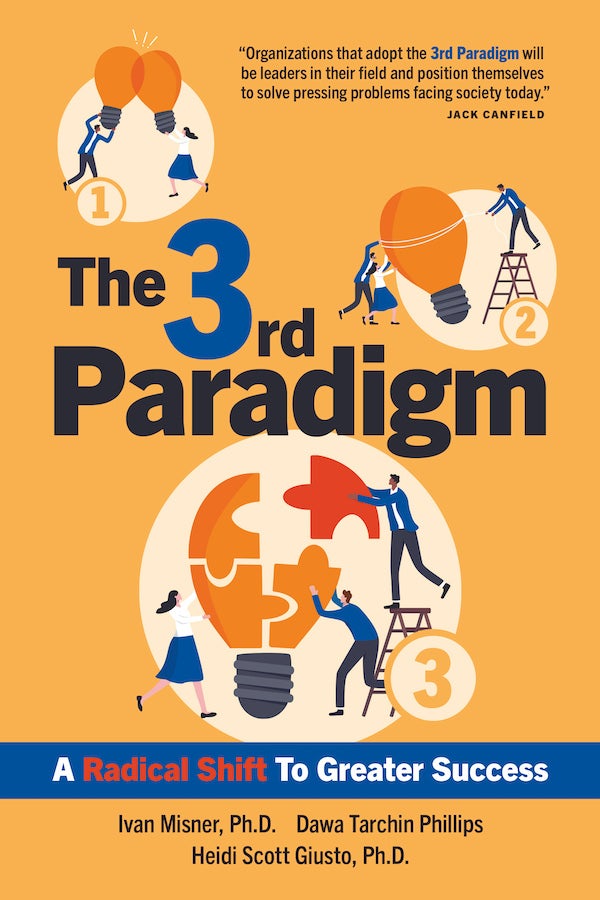Imagine a world where you can tackle the greatest, most challenging problems with a proven approach that leads to unmatched success. That is the premise and the promise of the new book, The Third Paradigm: A Radical Shift to Greater Success, written by Dr. Ivan Misner, Dr. Heidi Scott Giusto and Dawa Tarchin Phillips.
In the following excerpt, the authors discuss the state of the relationships between businesses with their competitors, their customers, and their internal teams.
We live in an age of sweeping conflict, widespread skepticism, and intense anxiety. Contention feels pervasive. Balanced discourse is a thing of the past, and pundits constantly tell us what’s wrong with society. People complain like it’s an Olympic event, and gurus in the marketplace obsess over the massive problems they see in the world. Negativity seems to be the norm.
However, we believe there is hope. There is an answer, and it starts with focusing on the solutions. When people focus on problems, they become world-class experts on “the problem.” When they focus on solutions, they can become world-class experts on “the solution.” We believe “the solution” to today’s massive challenges lie within the 3rd Paradigm.
As a reference point, a paradigm is a philosophical framework or discipline within which theories and laws are formulated. We believe we are entering the era of the 3rd Paradigm. Let us take you on a short journey through what we define as the three paradigms of the modern era.
The 1st Paradigm
The 1st Paradigm is the era of competition. This paradigm was formulated within the framework of the laws of production by early pioneers of business thinking. Formal theories of management began to be developed in the late 1800s by experts like Frederick Taylor, Frank and Lillian Gilbreth, Max Weber, and others who focused on issues like workflow, economic efficiency, and labor productivity. This was the era of “scientific management,” which was the beginning of business the- ory. Scientific management’s focus on production led directly to the 1st Paradigm’s emphasis on competition.
Buy The Third Paradigm: A Radical Shift to Greater Success | Entrepreneur Bookstore | Amazon | Barnes & Noble
The 1st Paradigm was so focused on productivity and competition that it failed to account for the needs of the people in the workforce. Competition was about gaining something by defeating your rivals or establishing superiority over them. It meant having a winner and a loser. The impact this had on individuals was generally minimized—unless it had an impact on productivity.
Can you imagine living in this production-oriented, competitive model today? Sixty-hour workweeks would be the norm, there would be few—if any—breaks, you’d be expected to work during much of your current lunchtime, safety regulations would be nonexistent, and children might be working right next to you in a factory. In most “developed” nations, that now seems inconceivable, but in the late 19th and early 20th centuries, it was common throughout the world. In those countries where employees are still required to work extreme hours, it can easily lead to burnout, stress, and dissatisfaction in the workplace.
You might even be working in an environment like this right now. Did you find yourself nodding your head when you read about routinely working 60-hour weeks, eating lunch quickly—or even at your desk— and feeling stressed and burned out? If so, your company might be stuck in the 1st Paradigm, so focused on “getting ahead” of the competition that workers like yourself are left behind. If so, know there is a better way to do business.
The 2nd Paradigm
The 2nd Paradigm is the era of cooperation. This paradigm evolved over time as people learned that a strictly production-oriented approach did not take into account the interaction of the people involved in
the process. This era was about two or more people working together toward shared goals. The focus on acting together for a common purpose started to evolve in the 1960s. Around this time, MIT management professor Douglas McGregor published his groundbreaking book The Human Side of Enterprise (1960), which introduced the concepts of Theory X and Theory Y. His framework highlights the motivating role of job satisfaction and argues that people can do their work without constant direct supervision. McGregor insisted that people are one of the most valuable assets for driving organizational success and that success comes from people being highly engaged in the process, with management recognizing employee contributions. His theory further focused on the motivating role of job satisfaction for individuals in the workplace.
We may be puzzled by this because these ideas seem so obvious now, but they weren’t at the start of the 2nd Paradigm. This was, in fact, revolutionary management thinking in its day.
During the time of the 2nd Paradigm, management consultant Peter Drucker developed the MBO process (Management by Objective), whereby managers and employees could identify common goals, define their areas of responsibility, and determine measures to guide the contributions of each individual. These and other advancements led to forms of collaborative project management, which enabled teams of people to collaborate across departmental, corporate, and national boundaries to achieve organizational objectives.
Today’s organizations are much more collaborative. Old command-and-control methods have largely been replaced by much more openness and transparency than during the 1st Paradigm. Cooperation focused on better communication and compromise.
The collaborative approach used in large companies has trickled down to small and medium-sized businesses as well. In a 2012 study entitled “Punching Above Their Weight,” published in the Journal of Small Business and Enterprise Development, it was found that the vast majority of small businesses (almost 78 percent) were very open to collaboration as a way of developing their operation.
Related: Best Business Books for Entrepreneurs
While the collaborative model was a massive improvement from the strictly competitive, production-oriented model, it was still lacking the full potential that the human experience can bring. In the 1980s, John Naisbitt wrote in his groundbreaking book, Megatrends, that humanity is moving toward a “high-tech, high-touch” society, saying that the more technologically advanced we become, the more important it is to become highly connected to people. Advances in management theory and technology have been leading society toward the next paradigm. It’s important to note, however, that the transition from one paradigm to another doesn’t happen overnight. They emerge by evolving over time.
The 3rd Paradigm
The 3rd Paradigm is the era of co-creation. This concept begins where cooperation leaves off. The difference between cooperation and co-creation is the difference between working together and creating together. You may collaborate on a project, but you co-create products and services. Co-creation is a significant step beyond cooperation. It is about bringing different parties together to actually produce, improve, or customize a product or service, based on a mutually desired outcome. We define co-creation as creating value through a joint effort, typically involving both internal and external stakeholders.
While some scholars recognized the theory of co-creation in the late 20th century, it was in the 21st century that the internet brought the concept to the forefront. Crowdsourcing has become a critical tool for engagement. Waze, the navigation app, used by millions of people is a good example of this concept. The widespread application of digital technology has made customer empowerment a must. creating together. Crowdsourcing products and services such as Waze, the crowdsourcing app used by millions of people, is an early example of co-creation.
Society is rapidly moving from a passive to a more participatory consumer culture. Co-creation plays a key role in this, since today’s consumers want a say in creating new products and services or improving existing ones. In their 2000 article in the Harvard Business Review, “Co-opting Customer Competence,” C.K. Prahalad and Venkatram Ramaswamy make the distinction that from approximately the year 2000 and beyond, customers transitioned from being a passive audience to being active players—becoming “co-creators as well as consumers of value.” In this age of co-creation, consumers want to work together with their favorite brands to ensure that products and services are adapted to meet their needs. In addition, many want to make sure there is a social cause related to the brand. Organizations engage in co-creation because they wish to foster the buy-in of stakeholder interest and increase value through innovation.
People tend to genuinely care about what they create.
Buy The Third Paradigm: A Radical Shift to Greater Success | Entrepreneur Bookstore | Amazon | Barnes & Noble

